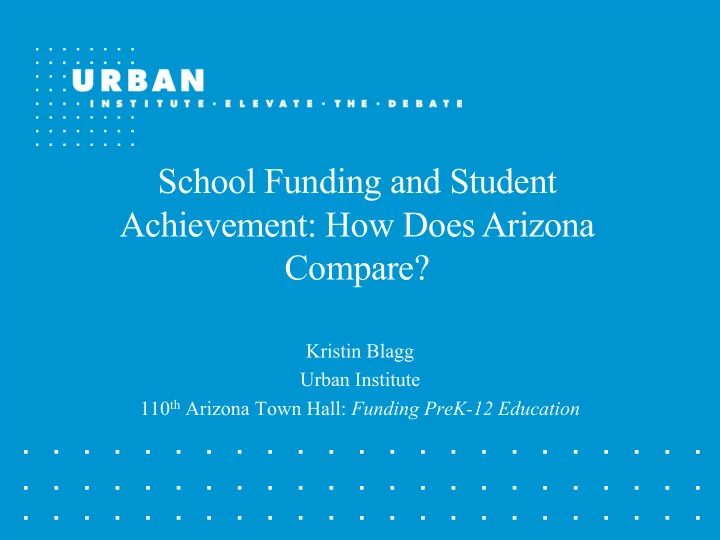

School Funding and Student Achievement: How Does Arizona Compare? Kristin Blagg Urban Institute 110 th Arizona Town Hall: Funding PreK-12 Education
School Funding and Student Achievement: How Does Arizona Compare? Academic Performance Funding Levels Funding Progressivity Funding Considerations
Academic Performance
How does Arizona stack up against other states on academic performance? Scores Adjusted For: Age Race/ethnicity Frequency of English spoken at home Special education status Free- and reduced-price lunch eligibility English language learner status
How does Arizona stack up against other states on academic performance? Adj. State Subject and Grade State Rank Rank 4 th Grade Math 36 th 27 th 4 th Grade Reading 44 th 41 st 8 th Grade Math 26 th 7 th 8 th Grade Reading 34 th 22 nd
How does Arizona stack up against other states on academic performance? 4 th Grade Math 8 th Grade Math 4 th Grade Reading 8 th Grade Reading
Funding Levels
How does school funding affect student achievement and other outcomes? Research on the link between school resources and student outcomes has historically been mixed (Hanushek 2003, Krueger 2002, Hedges et al 2016). Recent studies have found positive impacts , particularly for subgroups and on long-term outcomes: The implementation Seven years after state funding reforms, A 20 percent increase in of finance reforms is districts in the highest poverty quartile per-pupil spending over all associated with a experienced a 6-11 percentage point years of schooling results increase in student increase in graduation rates (Candelaria in a 0.9 additional years of performance on the and Shores 2017). education and 25 percent NAEP (Lafortune, higher earnings among Rothstein and children from poor families $1,000 of additional per-pupil spending Schanzenbach 2016) (Jackson, Johnson, and from 4 th to 7 th grade leads to a 3.3 Persico 2014). percentage point increase in post- secondary enrollment (Hyman 2014).
What does spending in Arizona look like? Overall Cost-Adjusted Per-Pupil Spending
What does spending in Arizona look like? Local Cost-Adjusted State Cost-Adjusted Federal Cost-Adjusted Spending Spending Spending
Funding Progressivity
How progressive is spending in Arizona? Progressivity Measure : average revenue per-pupil on all poor students, relative to nonpoor students. $10,000 x 10 +$12,000 x 30 District A 10+30 $10,000 per student 10 poor $10,000 x 90 +$12,000 x 70 90 non-poor 90+70 District B $12,000 per $11,500 = 1.057 student $10,875 30 poor or $625 difference 70 non-poor
Local Revenue Progressivity -$347
State and Local Progressivity -$347 +$212 -$135
Total Progressivity -$347 +$212 +$439 $304
Progressivity over time
Progressivity over time Local Cost-Adjusted State Cost-Adjusted Federal Cost-Adjusted
Funding Considerations
Funding is a partnership between revenue raised by districts and states
But district property wealth isn’t always indicative of student need Correlation 1 0.9 0.8 0.7 0.6 0.5 0.4 0.3 0.2 0.1 0 -0.1 -0.2 Correlation between median income and property value per student -0.3 Correlation between poverty rate and property value per student -0.4 -0.5 AR DE FL GA IL IA KY NY OH OR PA SD TX WA WV WI State
But district property wealth isn’t always indicative of student need Property Wealth Per Student $1,000,000 The correlation between median $900,000 household income $800,000 and per-student $700,000 property wealth in $600,000 Illinois is 0.32. $500,000 $400,000 $300,000 $200,000 $100,000 $0 $0 $20,000 $40,000 $60,000 $80,000 $100,000 $120,000 Median Household Income
Districts may respond to parameters set out in a given funding formula Use of weighted student counts help to allocate more resources to students who have more need, but also generate incentives to classify more students into the weighted categories (Greene and Forster 2002, Hoxby and Kuziemko 2004). When districts are responsible for providing most or all of the funding for capital expenditures (such as renovations or construction), property-wealthy districts may opt to spend on better facilities (Martorell, Stange, McFarlin 2016). Categorical funding may direct dollars to students in need, but limit flexibility for districts (Smith et al 2013).
District-level funding is not school-level funding (Chingos and Blagg 2017)
District-level funding is not school-level funding (Ejdemyr and Shores 2017)
Conclusions
Conclusions Relative to other states and to demographically-similar students, Arizona produced generally middle-of-the-pack academic results . Increases in school resources and funding may help improve academic outcomes and can have a lasting impact on post-secondary enrollment and earnings. Arizona generally spends less , in both local and state funds, on education, even after accounting for local cost differences. Arizona spending, as a total of local, state, and federal funds, is slightly progressive , though contributions from local and state funds alone are slightly regressive in directing funds to low-income students.
Questions
Recommend
More recommend